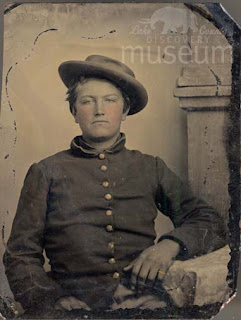Georgia D. Clarke's slide taken in Waukegan, circa 1910, titled, "Sherwin Wright-Edge of the Wild-Aurea-Flavescens."
Dunn Museum 93.32.381
For years, I have marveled at a group of 32 glass lantern slides in the Museum's collection. They are beautiful slides of trees, landscapes and flower gardens, hand-colored in spectacular tints, and attributed to G.D. Clarke.
When I looked at the slides last week, wanting to share them as springtime inspiration in this blog, I recalled that G.D. Clarke had not been researched. There are a number of individuals in our records who need to be researched to further our understanding of their lives and items they donated, and writing this post gives me a chance to do that. So, I set to work with my research, and was surprised by an interesting discovery.
Georgia D. Clarke (1871-1952), circa 1945. Waukegan News Sun.
Through census records, I was able to ascertain that Georgia's maiden name was Douglas. She was the granddaughter of nationally known nurseryman, Robert Douglas of Waukegan. Some of the subject matter of her slides were pine trees planted by her grandfather, Robert Douglas.
Georgia Douglas Clarke photographed these White Pines on the Dead River in Zion, IL, circa 1910 (above). The pines were planted by her grandfather, Robert Douglas, in what is today the Illinois Beach State Park.
Dunn Museum 93.32.361
English immigrant, Robert Douglas (1813-1897), started his nursery business in Waukegan in 1848. Within thirty years, Douglas became the largest grower of pines and spruces in the United States. About 1849, Douglas began the Lake County Fair as an arbor and floral exhibit at the courthouse in Waukegan. This project turned into the Lake County Agricultural Society and then into the Lake County Fair Association, which held the first county fair in 1852.
R. Douglas & Sons stationary, circa 1889. Dunn Museum 2013.18.
Douglas bought sapling pines from Europe and planted them in the sandy soil north of Waukegan along Lake Michigan in today's Illinois State Beach Park. The land was cheap, and Douglas thought the soil would be good for growing. He planted 200,000 seedlings, white and Scotch pine, some of which were reportedly sourced from the Black Forest of Baden-Wurttemberg in Germany. Their descendants can still be seen near the lakeshore at the state park.
"Dunes of Lake County" by G.D. Clarke, circa 1910. Dunn Museum 93.32.369
"Prickly Pear Cactus" by G.D. Clarke, circa 1910. Photo taken in what is today the Illinois Beach State Park.
Dunn Museum 93.32.355.
Douglas's extensive mail-order business brought him national recognition. In 1896, the Biltmore Estate in North Carolina (home to George Vanderbilt) purchased a large quantity of Douglas's evergreen stock.
"Peony Field" at 703 N. Sheridan Road, Waukegan, by G.D. Clarke, circa 1910.
Dunn Museum 93.32.387
The beautiful peony garden above was located down the bluff on Sheridan Road at Grand Avenue. The view is looking south with a potting shed in the background at left and a gas storage tank at right. As early as 1861, this area was designated on plat maps as "Greenhouses," and Grand Avenue did not run east of Sheridan Road until well into the 20th Century.
In the city directory, Georgia Clarke is listed as living across the street from this garden at 740 N. Sheridan Road, but her obituary states that she lived at 703 N. Sheridan Road, the address of this beautiful garden. According to her obituary, Georgia was "known throughout northern Ilinois as a garden expert... Her specialties were iris and peonies and the peony beds at the former family residence at 703 N. Sheridan Rd. were known far and wide."
Another view of the garden at 703 N. Sheridan Road, Waukegan. This G.D. Clarke slide is titled, "Hibiscus Mallow."
Dunn Museum 93.32.368.
During World War I, Georgia sold flowers from her garden to benefit Victory Memorial Hospital and the Red Cross.
Special thanks to Beverly Millard at the Waukegan Historical Society for additional information on Georgia D. Clarke and Elam L. Clarke.







































